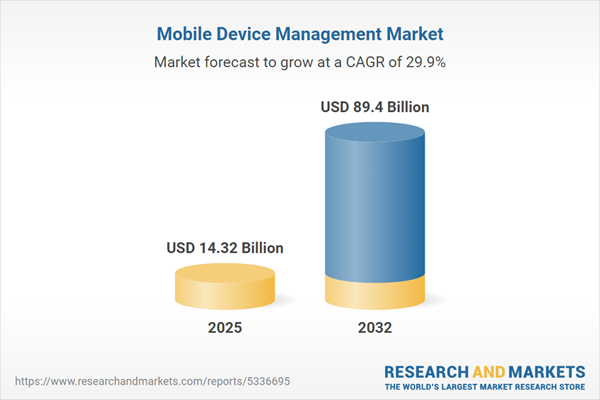Speak directly to the analyst to clarify any post sales queries you may have.
The mobile device management market equips senior decision-makers with oversight tools essential for securing corporate data and ensuring workforce efficiency in dynamic digital environments. As organizations adapt to new work models and technologies, effective MDM strategies play a pivotal role in aligning security, compliance, and operational agility.
Market Snapshot: Mobile Device Management Market Growth Trajectory
In 2024, the mobile device management market is valued at USD 11.02 billion, registering a compound annual growth rate (CAGR) of 29.91%. The market is projected to reach USD 14.32 billion in 2025 and USD 89.40 billion by 2032. This growth is driven by accelerated digital transformation, increasing device diversity, and greater emphasis on cybersecurity. The adoption of hybrid and remote work models has intensified demand for unified endpoint management solutions. Technology leaders are advancing governance frameworks and leveraging MDM to streamline complex workflows, ensure compliance, and anticipate future shifts within digital operations.
Scope & Segmentation of the Mobile Device Management Market
The mobile device management market integrates comprehensive solutions designed to address evolving enterprise needs for security, agility, and regulatory compliance. Senior executives benefit from tools that scale across organizational structures while maintaining control over dispersed endpoints and mobile assets.
- Component: Management software and professional services are designed for scalable, customizable integration, supporting business resilience and uninterrupted growth.
- Device Type: Laptops, smartphones, and tablets are managed through unified solutions, which ensures centralized control across distributed and remote operations.
- Functionality: MDM platforms support BYOD, COPE, and CYOD models, enabling organizations to implement flexible policies tailored to evolving security requirements.
- Platform Type: Solutions are compatible with Android, iOS, and Windows, supporting seamless deployment in heterogeneous IT environments.
- Deployment Type: Both cloud-based and on-premise options address unique organization preferences for efficiency, data residency, and compliance.
- Enterprise Size: MDM platforms scale to meet the requirements of SMEs and large organizations as workforce mobility and IT resource needs shift.
- Industry Verticals: Adoption is shaped by sector-specific challenges in banking, healthcare, government, manufacturing, IT, retail, and logistics, helping organizations address regulatory risk and operational demands.
- Regional Coverage: The Americas, EMEA, and Asia-Pacific each offer distinct regulatory landscapes and adoption trends, impacting market opportunities and technology investment strategies for global enterprises.
- Key Companies Profiled: Microsoft, VMware, IBM, Ivanti, Citrix Systems, Jamf Holding, SOTI, Zoho, Cisco Systems, and BlackBerry Limited influence standards and innovation within the mobile device management sector.
Key Takeaways: Strategic Insights for Senior Decision-Makers
- Centralized oversight through MDM enhances the enforcement of security policies and strengthens enterprise-wide compliance frameworks for IT assets.
- Zero trust architectures within MDM drive secure identity and access management, supporting transitions to flexible operating models.
- The integration of artificial intelligence and machine learning automates threat detection and compliance checks, improving incident response capabilities.
- Cloud-native platforms ensure sustained operational flexibility, while on-premise solutions deliver advanced control for specialized data management requirements.
- Strategic alliances with telecom providers extend the value of device lifecycle management, supporting large-scale mobile strategies across varied regulatory jurisdictions.
- Ongoing monitoring and adaptation to evolving privacy standards facilitate audit readiness and uphold risk management objectives for multinational organizations.
2025 U.S. Tariff Impact: Navigating Cost and Supply Chain Dynamics
Recent U.S. tariffs on imported mobile devices are prompting enterprises to reconfigure procurement and supply chain strategies. Many organizations are expanding vendor networks and prioritizing platform-agnostic MDM solutions to mitigate uncertainty and maintain operational continuity amid changing trade and regulatory conditions.
Methodology & Data Sources
This report draws from executive interviews, qualitative and quantitative assessments of leading MDM solutions, and in-depth regional market analysis. All findings are based on audited financial records, peer-reviewed research, and established industry benchmarks to ensure reliability and practical relevance.
Why This Report Matters
- Enables decision-makers to leverage actionable intelligence for investment, risk management, and compliance strategies within evolving digital infrastructures.
- Clarifies operational and regulatory considerations essential for IT planning, particularly as organizations adapt to workforce mobility and digital transformation.
- Supports resilient responses to regulatory shifts and secures technology investments across diversified supply chains and geographies.
Conclusion
This report provides senior leaders with clear insights to advance endpoint protection, support compliant operations, and maintain business resilience in the face of ongoing digital change.
Additional Product Information:
- Purchase of this report includes 1 year online access with quarterly updates.
- This report can be updated on request. Please contact our Customer Experience team using the Ask a Question widget on our website.
Table of Contents
3. Executive Summary
4. Market Overview
7. Cumulative Impact of Artificial Intelligence 2025
Companies Mentioned
The companies profiled in this Mobile Device Management market report include:- Microsoft Corporation
- VMware, Inc.
- International Business Machines Corporation
- Ivanti, Inc.
- Citrix Systems, Inc.
- Jamf Holding Corp.
- SOTI Inc.
- Zoho Corporation
- Cisco Systems, Inc.
- BlackBerry Limited
Table Information
| Report Attribute | Details |
|---|---|
| No. of Pages | 184 |
| Published | October 2025 |
| Forecast Period | 2025 - 2032 |
| Estimated Market Value ( USD | $ 14.32 Billion |
| Forecasted Market Value ( USD | $ 89.4 Billion |
| Compound Annual Growth Rate | 29.9% |
| Regions Covered | Global |
| No. of Companies Mentioned | 11 |









